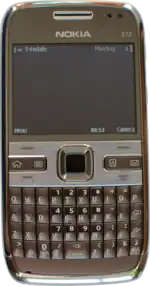 | |
| Manufacturer | Nokia |
|---|---|
| Compatible networks | GSM 800/900/1800/1900 MHz Tri Band UMTS/HSPDA/HSUPA/850/1900/2100 MHz (North American version) |
| Availability by region | November 2009 |
| Predecessor | Nokia E71 |
| Successor | Nokia E6 Nokia E73 Mode |
| Related | Nokia E52/E55 Nokia E63 Nokia 6720 classic |
| Type | Candybar smartphone |
| Form factor | Bar |
| Dimensions | 114 × 59.5 × 10.1 mm |
| Mass | 128 g (with battery) |
| Operating system | S60 3rd Edition Feature Pack 2 UI on Symbian OS v9.3 |
| CPU | 600 MHz ARM11 processor |
| Memory | 250 MiB internal user storage ROM: 512 MiB SDRAM: 128 MiB ~45 MiB free executable RAM |
| Removable storage | MicroSDHC Hot-swappable, support for up to 32GiB |
| Battery | BP-4L, 3.7V 1,500 mAh lithium-polymer |
| Display | 320 × 240 px (0.1 megapixels), 2.36 in, up to 16.7 million colours[1] |
| Rear camera | 5-megapixel (2592 × 1944 pixels) with autofocus and LED flash |
| Front camera | Front-facing |
| Connectivity | WLAN Wi-Fi 802.11 b, g, Integrated & Assisted GPS, Bluetooth 2.0, micro USB, 3.5 mm audio jack |
| Data inputs | QWERTY thumb keyboard, optical navigation key |
| Other | FOTA (Firmware update over the air) accelerometer sensor ambient light sensor magnetometer sensor digital compass[1] |
The Nokia E72 is a smartphone from the Nokia Eseries range manufactured in Finland. The Nokia E72 was announced on June 15, 2009 at the Nokia Connections 2009 event in Singapore.[2] It is the successor to the Nokia E71 and is based on a similar design and form factor, and offers a similar feature set. The Nokia E72 is a business-oriented phone (as all Eseries devices) and has standard features including mobile email, calendar and instant messaging among many others with its Symbian-based S60 3rd Edition Feature Pack 2 operating system.
The Nokia E72 has a new Optical Navi Key feature in addition to the standard D-pad used on many other Nokia devices including the Nokia E71 – this is said to improve the ease of scrolling through menus, emails, Internet browser, and images as it is an optical sensor in addition to a series of closely spaced buttons. In comparison to its predecessor, the Nokia E72 is said to have a higher level of performance (likely due to the faster 600 MHz ARM processor) and also includes a 5-megapixel auto focusing camera. Other changes and improvements are software-based including changes to the user interface and built-in messaging application among others.
The Nokia E73 Mode is a USA feature phone for T-Mobile USA, with support for T-Mobile's UMA service and Band IV support for 3G. It is a different piece of hardware internally from the E72.
The current firmware of this device is 91.004 published on 2 June 2012 (to check the current firmware, one may dial *#0000#).
The Vertu Constellation Quest from 2010 is based on the E72 design.
Features and enhancements from E71
 5-megapixel camera, lithium ion battery and stainless steel cover of the Nokia E72
5-megapixel camera, lithium ion battery and stainless steel cover of the Nokia E72 Back
Back Black E72
Black E72
New features
- Symbian OS 9.3, Series 60 v3.2 UI, Feature Pack 2.
- Optical navi key, along with the conventional D-Pad
- 3.5 mm audio jack
- Ovi Maps with free lifetime drive and walk voice assisted navigation
- Lifetime free Nokia Messaging service (discontinued)
- Use of front-facing camera (video call, VGA snapshots and QCIF videos for 15 seconds)
- USB charging
- Magnetometer sensor and digital compass
- RDS support
- PictBridge
- uPnP media streaming support (not present on E73)
- UMA (E73)
Upgrades
- Modified design and look compared to E71.
- 3.5 mm jack in contrast to the 2.5 mm jack used in the E71.
- 12 hours of talktime (2G) instead of the E71's 10 hours (2G).
- Tri-band UMTS/HSDPA/HSUPA instead of dual-band
- HSDPA support of up to 10.2 Mbit/s instead of 3.6
- Added HSUPA at 2.0 Mbit/s
- Improved CPU clock speed from 369 MHz to 600 MHz
- Real time Push e-mail HTML
- Improved reception from the E71's fluctuating signal reception
- 5-megapixel camera (up from 3.2)
- VGA at 15 frame/s (E72) rather than QVGA at 15 frame/s (E71)
- New flashlight feature (it can be activated by holding down the space bar)
See also
- Nokia Eseries
- Nokia E5-00 Reduced-cost version of the E72
- Nokia N72
- Nokia E73 Mode
References
Further reading
- Nokia E72 User Guide (PDF). Nokia Corporation. Archived from the original (PDF) on 2017-05-27. Retrieved 2018-10-30.
- Nokia E73 User Guide (PDF). Nokia Corporation.